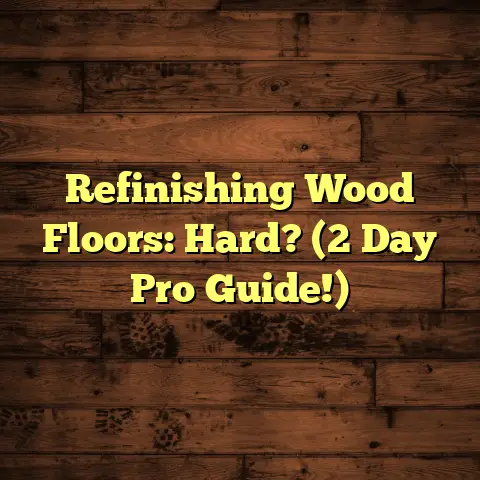Tile Over Linoleum? (1 Mistake Costly!)
Let me tell you a story. It’s about a time I thought I was being clever, saving money, and getting a beautiful new tiled floor all at once. Oh, how wrong I was!
It all started with a dated kitchen. The linoleum flooring was straight out of the 70s – you know, that avocado green pattern that just screams “outdated”? I was itching for an upgrade, and tile was the obvious choice.
I envisioned a gorgeous, modern kitchen with sleek, new tiles. I could almost feel the cool, smooth surface under my bare feet as I cooked.
The problem? The cost of ripping up the old linoleum and prepping the subfloor seemed astronomical.
That’s when I stumbled upon the idea of tiling directly over the existing linoleum. “Why not?” I thought. “It’ll save time, money, and a whole lot of hassle!”
I dove headfirst into research. I consulted my dad, who’s a pretty handy guy, and scoured online forums. The consensus seemed to be: “Yeah, you can do it! Just make sure the linoleum is in good shape.”
So, armed with this (mis)information and a can-do attitude, I embarked on my ill-fated tiling adventure. Let me tell you, the excitement quickly turned into a costly lesson.
The Dilemma: A Recipe for Disaster
I started by meticulously cleaning the linoleum. I scrubbed, rinsed, and scrubbed again, convinced I was creating the perfect surface for the tile adhesive.
I even used a deglosser to rough it up a bit, thinking that would help the tiles stick better.
Looking back, that was probably my first mistake. I should’ve paid closer attention to the linoleum itself.
Was it firmly adhered to the subfloor? Was it damaged or peeling anywhere? The answer to both of those questions, in hindsight, was a resounding “NO!”
But I was too eager, too focused on saving time and money to see the warning signs. I was so confident that I even bragged to my neighbor, “I’ll have a brand new kitchen floor by the end of the weekend!” Famous last words.
I gathered my tools: trowel, tile spacers, level, and a bucket of thin-set mortar that promised the world. I even watched a few YouTube tutorials to make sure I was doing everything “right.”
Then came the pivotal moment, the one that sealed my fate. I started spreading the thin-set, carefully placing each tile, pressing it firmly into the adhesive. Everything seemed to be going smoothly… at first.
But as I worked my way across the kitchen, I started noticing subtle inconsistencies. Some tiles seemed a little higher than others. Others felt slightly “squishy” under my feet. My heart started to sink.
The linoleum, I realized, wasn’t as stable as I thought. Its texture, combined with its questionable adhesion to the subfloor, was creating an uneven, unstable base for my beautiful new tiles.
The frustration began to mount. I tried to compensate for the unevenness by adding more thin-set under some tiles, less under others. It was a futile effort.
The tiles were starting to look crooked and unprofessional. The dream of a perfect, modern kitchen floor was quickly turning into a nightmare.
The Costly Mistake: When Good Intentions Go Bad
The problems didn’t stop once the tiles were laid. Oh no, they were just beginning. Remember that thin-set mortar that promised the world? It lied.
Adhesive Issues: A Sticky Situation
The adhesive simply didn’t bond well to the linoleum. I started noticing tiles popping up, especially in areas with more foot traffic. It was like playing a constant game of whack-a-mole, except the moles were ceramic tiles.
I tried re-gluing them, using stronger adhesives, even resorting to construction adhesive in desperation. Nothing worked for long. The tiles kept coming loose, creating a tripping hazard and an eyesore.
According to a study by the Tile Council of North America (TCA), proper surface preparation is crucial for tile adhesion. In fact, improper preparation is cited as the leading cause of tile failure, accounting for over 60% of all issues. I was definitely part of that statistic.
Uneven Surface: A Wobbly Foundation
The linoleum’s uneven texture wreaked havoc on the tiles’ alignment. No matter how hard I tried, I couldn’t get them perfectly level. Some tiles were slightly higher than others, creating a noticeable wobble when you walked across the floor.
And then there were the cracks. The unstable base caused some of the tiles to crack under pressure. Every time I heard that telltale “pop,” my heart sank a little further.
I even tried to replace the cracked tiles, but it was impossible to match the grout lines perfectly. The result was a patchwork floor that looked even worse than the original linoleum.
Long-Term Consequences: The Gift That Keeps on Giving
The worst part? The problems didn’t stay on the surface. The unstable tile allowed moisture to seep through, creating a breeding ground for mold and mildew underneath.
I started noticing a musty smell in the kitchen, and then came the telltale signs of water damage on the adjacent walls. It was a disaster.
I had to rip up the entire floor – tiles, linoleum, and all – to address the mold and water damage. The project that was supposed to save me money ended up costing me thousands of dollars in repairs.
According to the National Association of Realtors, water damage and mold remediation can cost anywhere from $500 to $6,000, depending on the extent of the damage. My experience was definitely on the higher end of that range.
The emotional toll was even worse. The stress of dealing with the constant repairs, the frustration of seeing my dream kitchen turn into a nightmare, and the guilt of making such a costly mistake weighed heavily on me.
I even had a few sleepless nights, lying awake and wondering how I could have been so foolish.
Lessons Learned: Hindsight is 20/20
Looking back, I realize how many mistakes I made. The biggest one was underestimating the importance of proper preparation. I was so focused on saving time and money that I ignored the warning signs and cut corners.
If I could do it all over again, I would definitely remove the linoleum before tiling. It would have been more work, more expensive, and more time-consuming, but it would have saved me a whole lot of heartache in the long run.
I also learned the importance of researching best practices for flooring installations. I relied too much on advice from friends and online forums, without verifying the information with reputable sources.
I should have consulted with a professional flooring contractor before starting the project. They would have been able to assess the condition of the linoleum and advise me on the best course of action.
According to the Better Business Bureau, hiring a licensed and insured contractor can help protect you from shoddy workmanship and potential liability issues. It’s an investment that’s well worth the cost.
I also realized the limitations of different flooring types and the implications of layering materials. Linoleum is a flexible, resilient flooring, while tile is a rigid, unforgiving material.
Trying to combine the two without proper preparation was a recipe for disaster. It’s like trying to build a house on a foundation of sand – it’s just not going to work.
Alternative Solutions: What You Should Do Instead
So, what should you do if you’re considering tiling over linoleum? The short answer is: probably don’t. But let’s explore some alternative solutions.
Removing the Linoleum: The Right Way to Do It
The best option is almost always to remove the linoleum before tiling. It’s more work, but it ensures a solid, stable base for your new tiles.
The process involves scoring the linoleum with a utility knife, peeling it up in sections, and scraping away any remaining adhesive. It’s a messy job, but it’s worth it.
Once the linoleum is removed, you’ll need to inspect the subfloor for any damage or imperfections. Repair any cracks or holes, and level the surface with a self-leveling compound if necessary.
Then, apply a layer of cement backer board to create a smooth, stable base for the tile. This will help prevent cracking and ensure proper adhesion.
When Tiling Over Linoleum Might Be Feasible
There are a few scenarios where tiling over linoleum might be feasible, but they’re rare.
-
The linoleum is in excellent condition: It must be perfectly flat, firmly adhered to the subfloor, and free of any damage or imperfections.
-
You’re using small, lightweight tiles: Large, heavy tiles are more likely to crack or come loose if the underlying surface is unstable.
-
You’re using a flexible adhesive: A flexible adhesive can help accommodate slight movements in the linoleum without causing the tiles to crack.
Even in these scenarios, it’s still a risky proposition. I would strongly recommend consulting with a professional flooring contractor before proceeding.
Other Flooring Options: Explore Your Choices
If you’re looking for a DIY-friendly flooring option, there are plenty of alternatives to tile.
-
Luxury Vinyl Plank (LVP): LVP is a durable, waterproof, and easy-to-install flooring option that mimics the look of wood or tile. It’s a great choice for kitchens and bathrooms.
-
Laminate Flooring: Laminate flooring is another affordable and easy-to-install option that comes in a wide variety of styles and colors.
-
Sheet Vinyl: Sheet vinyl is a seamless, waterproof flooring option that’s ideal for bathrooms and laundry rooms.
These options are generally more forgiving than tile and can be installed over existing flooring with minimal preparation.
Conclusion: A Costly Lesson Learned
My experience with tiling over linoleum was a painful, but ultimately valuable, lesson. I learned the importance of proper preparation, the value of professional advice, and the limitations of DIY projects.
While DIY projects can be rewarding, they also come with risks, especially when foundational aspects like flooring are involved. Cutting corners to save time and money can often lead to more significant problems down the line.
I encourage you to learn from my mistakes and embrace the journey of home improvement with an open mind and a readiness to adapt. Don’t be afraid to ask for help when you need it, and always prioritize quality over convenience.
And remember, every mistake is an opportunity for growth. My ill-fated tiling adventure taught me a lot about flooring, home improvement, and the importance of doing things right the first time.
It also led me to become a more informed and cautious homeowner, and that’s something I wouldn’t trade for anything. Now, if you’ll excuse me, I have to go check for mold. Just kidding! (Mostly.)





